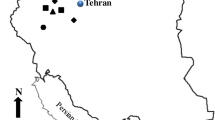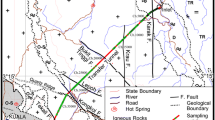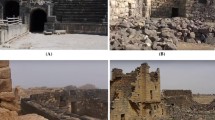Abstract
The unconfined compressive strength (UCS) of rocks is an important design parameter in rock engineering and geotechnics, which is required and determined for rock mechanical studies in mining and civil projects. This parameter is usually determined through a laboratory UCS test. Since the preparation of high-quality samples is difficult, expensive and time consuming for laboratory tests, development of predictive models for determining the mechanical properties of rocks seems to be essential in rock engineering. In this study, an attempt was made to develop an artificial neural network (ANN) and multivariable regression analysis (MVRA) models in order to predict UCS of rock surrounding a roadway. For this, a database of laboratory tests was prepared, which includes rock type, Schmidt hardness, density and porosity as input parameters and UCS as output parameter. To make a database (including 93 datasets), different rock samples, ranging from weak to very strong types, are used. To compare the performance of developed models, determination coefficient (R 2), variance account for (VAF), mean absolute error (E a) and mean relative error (E r) indices between predicted and measured values were calculated. Based on this comparison, it was concluded that performance of the ANN model is considerably better than the MVRA model. Further, a sensitivity analysis shows that rock density and Schmidt hardness were recognized as the most effective parameters, whereas porosity was considered as the least effective input parameter on the ANN model output (UCS) in this study.







Similar content being viewed by others
References
Bieniawski ZT (1974) Estimating the strength of rock materials. J S Afr Inst Min Metall 74:312–320
Onodera TF, Yoshinaka R, Oda M (1974) Weathering and its relation to mechanical properties of granite. In: Proceedings of the 3rd congress of ISRM, vol II(A), Denver, USA, pp 71–78
Fahy MP, Guccione MJ (1979) Estimating strength of sandstones using petrographic thin-section data. Bull Assoc Eng Geol 16(4):467–485
Prikryl R (2001) Some microstructural aspects of strength variation in rocks. Int J Rock Mech Min Sci 38:671–682
Zorlu K, Gokceoglu C, Ocakoglu F, Nefeslioglu HA, Acikalin S (2008) Prediction of uniaxial compressive strength of sandstones using petrography-based models. Eng Geol 96:141–158
Cevik A, Sezer EA, Cabalar AF, Gokceoglu C (2011) Modeling of the uniaxial compressive strength of some clay-bearing rocks using neural network. Appl Soft Comput 11:2587–2594
ISRM (1985) Suggested method for determining point load strength. Int J Rock Mech Min Sci Geomech Abstr 22:51–60
ASTM (1986) Standard test method of unconfined compressive strength of intact rock core specimens. D2938
Alber M, Kahraman S (2009) Predicting the uniaxial compressive strength and elastic modulus of a fault breccia from texture coefficient. Rock Mech Rock Enggnog 42:117–127
Kayabali K, Selcuk L (2010) Nail penetration test for determining the uniaxial compressive strength of rock. Int J Rock Mech Min Sci 47:265–271
Kahraman S (2001) Evaluation of simple methods for assessing the uniaxial compressive strength of rock. Int J Rock Mech Min Sci 38(7):981–994
Shakoor A, Bonelli RE (1991) Relationship between petrographic characteristics, engineering index properties and mechanical properties of selected sandstone. Bull Assoc Eng Geol 28(1):55–71
Tsiambaos G, Sabatakakis N (2004) Considerations on strength of intact sedimentary rocks. Eng Geol 72:261–273
Chau KT, Wong RHC (1996) Uniaxial compressive strength and point load strength. Int J Rock Mech Min Sci Geomech Abstr 33:183–188
Yilmaz I, Sendir H (2002) Correlation of Schmidt hardness with unconfined compressive strength and young modulus in gypsum from Sivas (Turkey). Eng Geol 66:211–219
Fener M, Kahraman S, Bilgil A, Gunaydin O (2005) A comparative evaluation of indirect methods to estimate the compressive strength of rocks. Rock Mech Rock Eggnog 38(4):329–334
Sonmez H, Tuncay E, Gokceoglu C (2004) Models to predict the uniaxial compressive strength and the modulus of elasticity for Ankara Agglomerate. Int J Rock Mech Min Sci 41(5):717–729
Sonmez H, Gokceoglu C, Medley EW, Tuncay E, Nefeslioglu HA (2006) Estimating the uniaxial compressive strength of a volcanic bimrock. Int J Rock Mech Min Sci 43(4):554–561
Heidari M, Khanlari GR, Torabi Kaveh M, Kargarian S (2011) Predicting the uniaxial compressive and tensile strengths of gypsum rock by point load testing. Rock Mech Rock Eng. doi:10.1007/s00603-011-0196-8
Yasar E, Erdogan Y (2004) Correlating sound velocity with the density, compressive strength and Young’s modulus of carbonate rocks. Int J Rock Mech Min Sci 41(5):871–875
Dehghan S, Sattari Gh, Chehreh Chelgani S, Aliabadi MA (2010) Prediction of uniaxial compressive strength and modulus of elasticity for Travertine samples using regression and artificial neural networks. Mini Sci Technol 20(1):0041–0046
Verwaal W, Mulder A (1993) Estimating rock strength with the Equotip hardness tester. Int J Rock Mech Min Sci Geomech Abstr 30(6):659–662
Asef MR (1995) Equotip as an index test for rock strength properties. M.Sc. thesis, ITC Delft
Alvarez Grimaa M, Babuska R (1999) Fuzzy model for the prediction of unconfined compressive strength of rock samples. Int J Rock Mech Min Sci 36:339–349
Khandelwal M, Roy MP, Singh PK (2004) Application of artificial neural network in mining industry. Ind Min Eng J 43:19–23
Singh VK, Singh D, Singh TN (2001) Prediction of strength properties of some schistose rocks from petrographic properties using artificial neural networks. Int J Rock Mech Min Sci 38(2):269–284
Yılmaz I, Yuksek AG (2008) An example of artificial neural network (ANN) application for indirect estimation of rock parameters. Rock Mech Rock Eng 41(5):781–795
Tiryaki B (2008) Predicting intact rock strength for mechanical excavation using multivariate statistics, artificial neural networks and regression trees. Eng Geol 99:51–60
Ali M, Chawathe A (2000) Using artificial intelligence to predict permeability from petrographic data. Comput Geosci 26:915–925
Ranjith PG, Khandelwal M (2011) Artificial neural network for prediction of air flow in a single rock joint. Neural Comput Appl. doi:10.1007/s00521-011-0595-5
Mert E, Yilmaz S, Inal M (2011) An assessment of total RMR classification system using unified simulation model based on artificial neural networks. Neural Comput Appl 20:603–610
Çanakcı H, Baykasoğlu A, Güllü H (2009) Prediction of compressive and tensile strength of Gaziantep basalts via neural networks and gene expression programming. Neural Comput Appl 18:1031–1041
Bhatnagar A, Khandelwal M (2011) An intelligent approach to evaluate drilling performance. Neural Comput Appl. doi:10.1007/s00521-010-0457-6
Amini H, Gholami R, Monjezi M, Torabi SR, Zadhesh J (2011) Evaluation of fly rock phenomenon due to blasting operation by support vector machine. Neural Comput Appl. doi:10.1007/s00521-011-0631-5
Rezaei M, Monjezi M, Ghorbani Moghaddam S, Farzaneh F (2011) Burden prediction in blasting operation using rock geomechanical properties. Arab J Geosci. doi:10.1007/s12517-010-0269-0
Simpson PK (1990) Artificial neural system-foundation, paradigm, application and implementations. Pergamon Press, New York
Kosko B (1994) Neural networks and fuzzy systems: a dynamical systems approach to machine intelligence. Prentice Hall, New Delhi
Khandelwal M, Kumar DL, Mohan Y (2011) Application of soft computing to predict blast-induced ground vibration, Engineering with computers. Eng Comput 27:117–125
Neaupane KM, Achet SH (2004) Use of back propagation neural network for landslide monitoring: a case study in the higher Himalaya. Eng Geol 74:213–226
Basheer IA, Hajmeer M (2000) Artificial neural networks: fundamentals, computing, design, and application. J Microbiol Method 43:3–31
Demuth H, Beal M, Hagan M (1996) Neural network tool box 5 user’s guide. The Math Work, Natick
Khandelwal M, Singh TN (2006) Prediction of blast induced ground vibrations and frequency in opencast mine-a neural network approach. J Sound Vibrat 289:711–725
Haykin S (1999) Neural networks, a comprehensive foundation, USA, 2nd edn. Prentice Hall, USA
Tzamos S, Sofianos AI (2006) Extending the Q system’s prediction of support in tunnels employing fuzzy logic and extra parameters. Int J Rock Mech Min Sci 43:938–949
Jennrich RI (1995) An Introduction to computational statistics-regression analysis. Prentice Hall, Englewood Cliffs, NJ
Jong YH, Lee CI (2004) Influence of geological conditions on the powder factor for tunnel blasting. Int J Rock Mech Min Sci 41(Supplement 1):533–538
Author information
Authors and Affiliations
Corresponding author
Rights and permissions
About this article
Cite this article
Majdi, A., Rezaei, M. Prediction of unconfined compressive strength of rock surrounding a roadway using artificial neural network. Neural Comput & Applic 23, 381–389 (2013). https://doi.org/10.1007/s00521-012-0925-2
Received:
Accepted:
Published:
Issue Date:
DOI: https://doi.org/10.1007/s00521-012-0925-2




